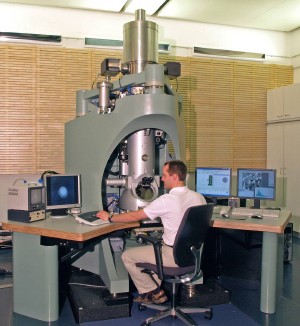Oct 20 2008
The special SESAM system, a high performance version of the LIBRA® 200 transmission electron microscope series from Carl Zeiss SMT, has been in use at the Stuttgart Center for Electron Microscopy (StEM) of the Max-Planck-Institute for Metals Research (MPI-MF) for the past 10 months. The StEM research group utilizes the system, among other things, for research work on plasmon resonances and opto-electronic semiconductor components. First results have been presented at the beginning of August during the international Microscopy + Microanalysis conference in Albuquerque (USA). "For the very first time, the MANDOLINE filter allows us to visualize the energy gap in semiconductor materials with high spatial resolution using energy-filtered imaging," explains Dr. Wilfried Sigle from the StEM.
 Dr. Christoph Koch, scientist at the StEM of the Max-Planck-Institute for Metals Research (Stuttgart/Germany) conducts experiments with the SESAM TEM.
Dr. Christoph Koch, scientist at the StEM of the Max-Planck-Institute for Metals Research (Stuttgart/Germany) conducts experiments with the SESAM TEM.
The Head of the Stuttgart Center for Electron Microscopy, PD Dr. Peter A. van Aken, has many expectations for the future: "The energy resolution of the SESAM, which is absolutely unique in transmission electron microscopy, opens up new possibilities to the StEM researchers, especially in the low energy-loss area, by pairing the high spatial resolution of a transmission electron microscope (TEM) with an energy resolution otherwise only accessible to optical spectroscopy. In this way it is possible to examine, for example, local electronic properties of semiconductors or the vibration states of electrons on the surfaces of tiny metal particles."
New TEM generation
The special feature of this system is already evident in its name: SESAM stands for Sub Electronvolt Sub Angstrom Microscope, i.e. a transmission electron microscope (TEM) that combines high spatial resolution with high energy resolution. Its technical advantage lies in the design of a specially corrected spectrometer for energy filtering (MANDOLINE filter). In conjunction with an electrostatic electron monochromator, producing an appropriately monochromated electron beam, this makes it possible to capture series of energy-filtered images with very high spatial and energy resolution for the first time. This allows the production of maps of chemical element distributions with almost atomic resolution.
The MANDOLINE filter, whose electron-optical design is based on the development work of Professor Dr. Harald Rose, makes the SESAM a totally unique TEM. At the same time, it is part of a series of pilot systems with which Carl Zeiss SMT is introducing a wide variety of corrector and filter technologies for transmission electron microscopes specific to the required application. One example: In April 2007, after several years of development, the CRISP system was installed at the caesar Research Center in Bonn, Germany. Its development earned Carl Zeiss the coveted R&D 100 Award in 2007. CRISP is characterized by an electrostatic electron monochromator, an aberration-corrected illumination system and an imaging energy filter. The monochromator and the aberration corrector were developed by the Heidelberg company CEOS. In addition, a system known as PACEM featuring a phase plate module for biological applications is currently being built for the Frankfurt Max-Planck-Institute for Biophysics.
Dr. Markus Dilger, Managing Director in the Nano Technology Systems division of Carl Zeiss SMT, is convinced that SESAM is a further decisive breakthrough in the application of filter and monochromator technologies for high- performance electron microscopy: "In recent years, we have invested heavily in the enhancement of our TEM systems and, in cooperation with our demanding key customers and suppliers, have taken their development to the very limits of what is technologically feasible. It is now our goal to also offer these technologies for standard systems. The LIBRA 200 MC with an integrated monochromator module is an initial product of this type which we successfully launched on the market last year." Just recently, in the beginning of October 2008, the LIBRA 200 MC has been awarded with the EuroAsia IC Industry Award 2008.